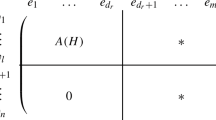Abstract
A code is a subset of the vertex set of a Hamming graph. The set of s-neighbours of a code is the set of all vertices at Hamming distance s from their nearest codeword. A code C is s-elusive if there exists a distinct code \(C'\) that is equivalent to C under the full automorphism group of the Hamming graph such that C and \(C'\) have the same set of s-neighbours. We show that the minimum distance of an s-elusive code is at most \(2s+2\), and that an s-elusive code with minimum distance at least \(2s+1\) gives rise to a q-ary t-design with certain parameters. This leads to the construction of: an infinite family of 1-elusive and completely transitive codes, an infinite family of 2-elusive codes, and a single example of a 3-elusive code. Answers to several open questions on elusive codes are also provided.
Similar content being viewed by others
References
Assmus Jr. E.F., Key J.D.: Designs and Their Codes, vol. 103. Cambridge Tracts in Math. Cambridge University Press, Cambridge (1994).
Berger T., Charpin P.: The automorphism group of generalized Reed-Muller codes. Discret. Math. 117(1), 1–17 (1993).
Borges J., Rifà J., Zinoviev V.A.: On completely regular codes. Probl. Inf. Transm. 55(1), 1–45 (2019).
Brouwer A.E.: Private communication (2014). Accepted April 10 2014.
Brouwer A.E., Cohen A.M., Neumaier A.: Distance-Regular Graphs, vol. 18. Springer, Berlin (1989).
Calderbank R., Kantor W.M.: The geometry of two-weight codes. Bull. Lond. Math. Soc. 18(2), 97–122 (1986).
Cameron P.J., van Lint J.H.: Designs, Graphs. Codes and Their Links. Cambridge University Press, Cambridge (1991).
Carlet C., Gaborit P.: Hyper-bent functions and cyclic codes. J. Comb. Theory Ser. A 113(3), 466–482 (2006).
Cvetkovic D., Rowlinson P., Simic S.: Eigenspaces of Graphs. Encyclopedia Math. Appl. Cambridge University Press, Cambridge (2008).
Delsarte P.: An Algebraic Approach to the Association Schemes of Coding Theory. Philips Research reports: Supplements. N. V. Philips’ Gloeilampenfabrieken (1973).
Gillespi N.I.: Neighbour transitivity on codes in Hamming graphs. Ph.D. thesis, The University of Western Australia, Perth, Australia (2011).
Gillespie N.I., Giudici M., Hawtin D.R., Praeger C.E.: Entry-faithful 2-neighbour transitive codes. Des. Codes Cryptogr. 79(3), 549–564 (2016). https://doi.org/10.1007/s10623-015-0069-3.
Gillespie N.I., Hawtin D.R.: Alphabet-almost-simple \(2\)-neighbour-transitive codes. Ars Math. Contemp. 14(2), 345–357 (2017).
Gillespie N.I., Hawtin D.R., Praeger C.E.: The structure of elusive codes in Hamming graphs. Preprint (arXiv:1404.0950v1) (2014).
Gillespie N.I., Hawtin D.R., Praeger C.E.: \(2 \)-Neighbour-transitive codes with small blocks of imprimitivity. Electron. J. Comb. 27(1), 1–16 (2020).
Gillespie N.I., Praeger C.E.: Neighbour transitivity on codes in Hamming graphs. Des. Codes Cryptogr. 67(3), 385–393 (2013). https://doi.org/10.1007/s10623-012-9614-5.
Giudici M., Praeger C.E.: Completely transitive codes in Hamming graphs. Eur. J. Comb. 20(7), 647–662 (1999).
Hawtin D.R., Gillespie N.I., Praeger C.E.: Elusive codes in Hamming graphs. Bull. Aust. Math. Soc. 88, 286–296 (2013). https://doi.org/10.1017/S0004972713000051.
Hawtin D.R., Praeger C.E.: Minimal binary \(2\)-neighbour-transitive codes. J. Comb. Theory Ser. A 171, (2020).
MacWilliams F.J., Sloane N.J.A.: The Theory of Error Correcting Codes. North-Holland Mathematical Library, North-Holland (1978).
Semakov N.V., Zinoviev V.A., Zaitsev G.V.: Uniformly packed codes. Probl. Inf. Transm. 7(1), 30–39 (1971).
Tokareva N.: Bent Functions: Results and Applications to Cryptography. Elsevier, Amsterdam (2015).
Acknowledgements
The author thanks Neil Gillespie, Cheryl Praeger and Andrea Švob for kindly reading drafts of this manuscript, and the anonymous referees for their very helpful comments.
Author information
Authors and Affiliations
Corresponding author
Additional information
Communicated by C. E. Praeger.
Publisher's Note
Springer Nature remains neutral with regard to jurisdictional claims in published maps and institutional affiliations.
This research was partially supported by an Australian Postgraduate Award and a University of Western Australia Safety-Net Top-Up Scholarship. This work has been supported in part by the Croatian Science Foundation under Project 6732.
Rights and permissions
About this article
Cite this article
Hawtin, D.R. s-Elusive codes in Hamming graphs. Des. Codes Cryptogr. 89, 1211–1220 (2021). https://doi.org/10.1007/s10623-021-00868-6
Received:
Revised:
Accepted:
Published:
Issue Date:
DOI: https://doi.org/10.1007/s10623-021-00868-6




